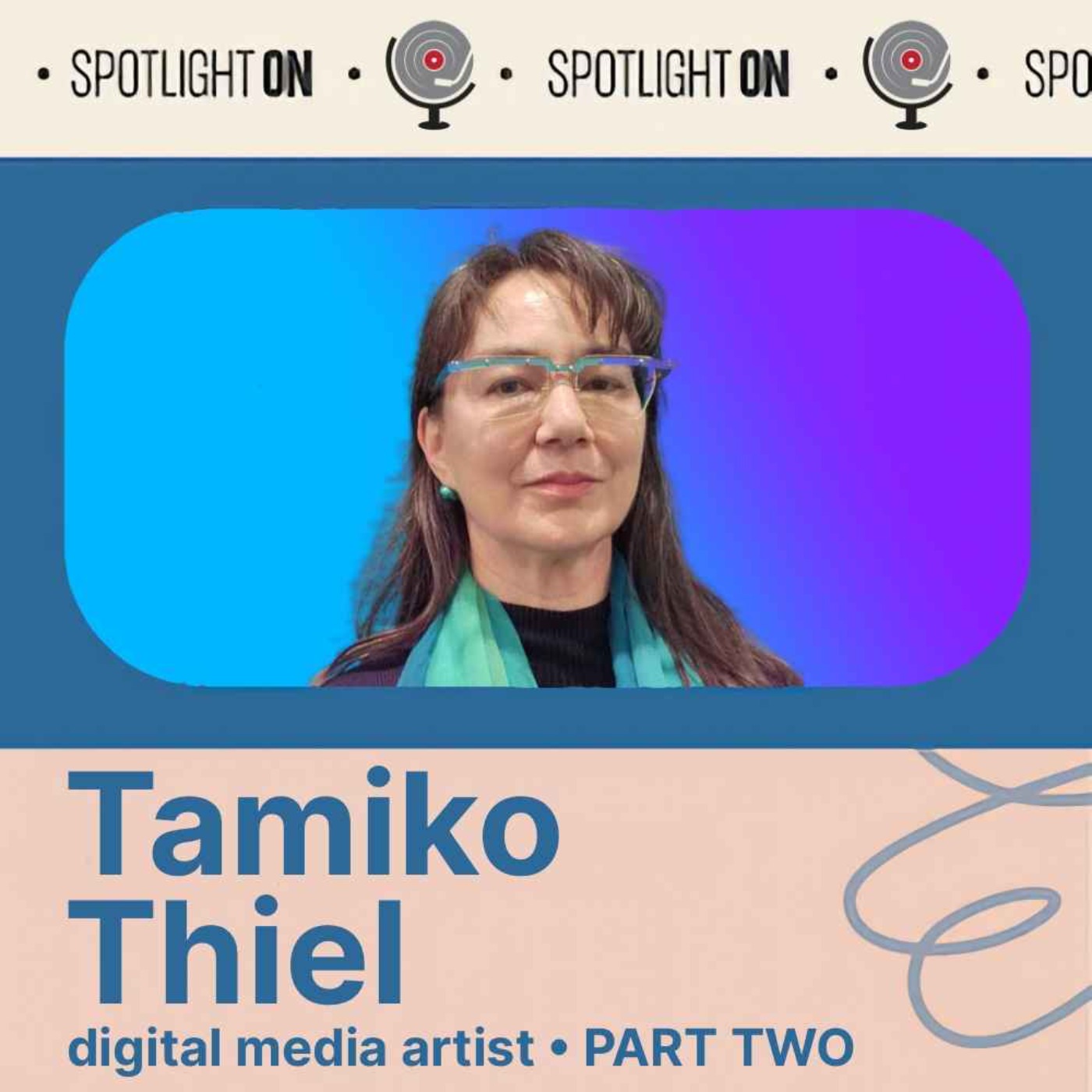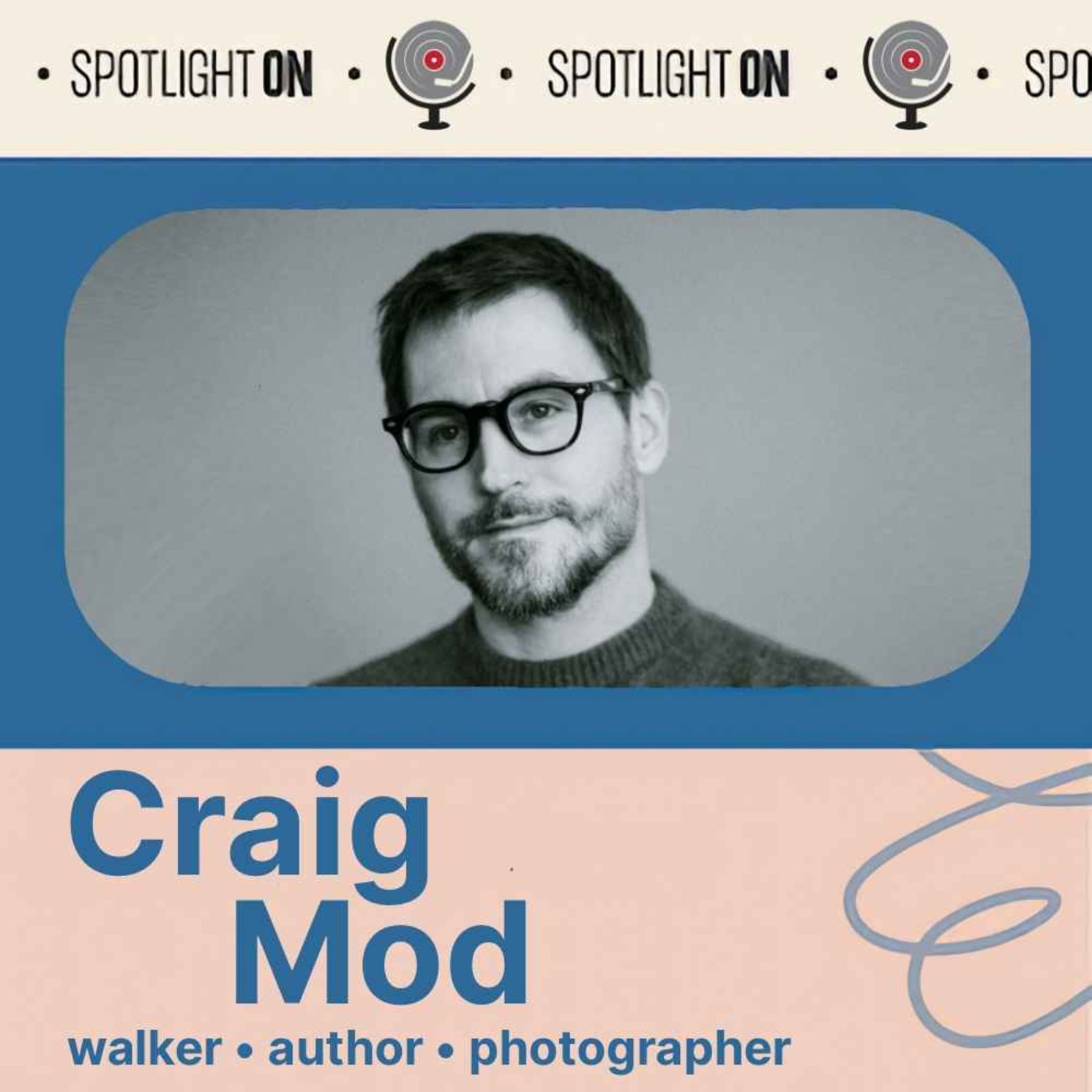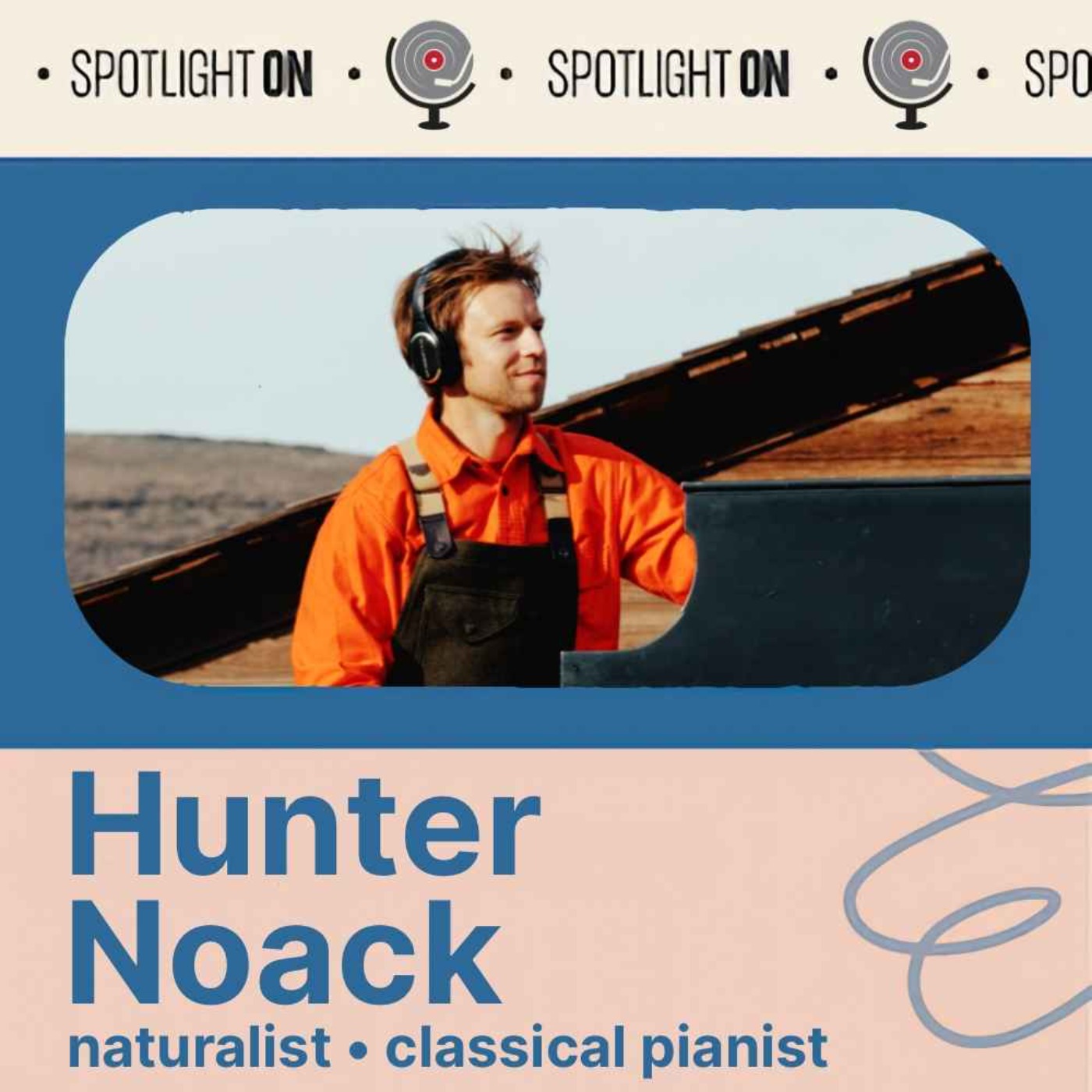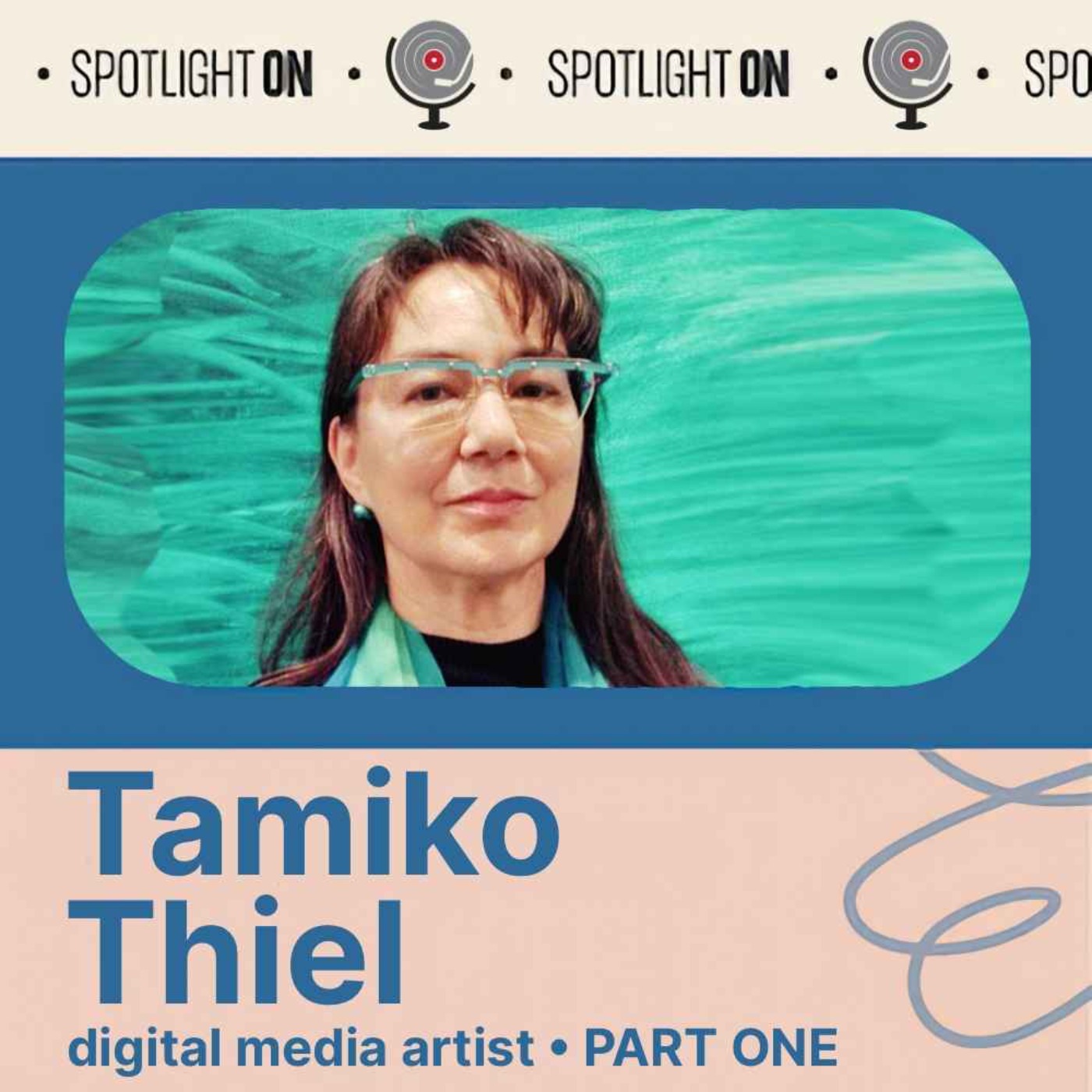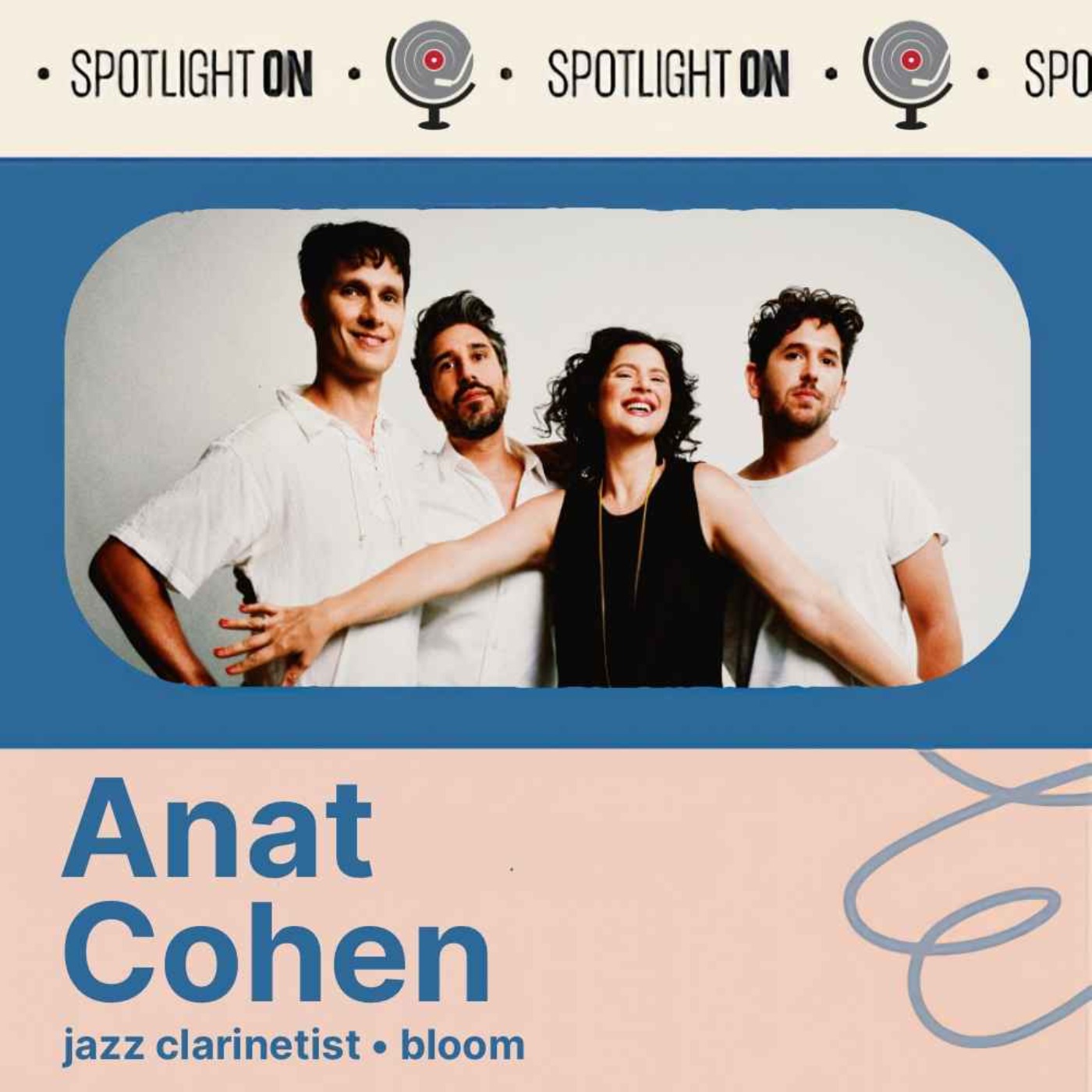Tamiko Thiel: part 2 - art at technology's edge

In the second part of our conversation, Tamiko Thiel discusses Beyond Manzanar, her collaboration with artist Zara Houshmand, where viewers confront the history of Japanese-American internment while drawing connections to contemporary persecution.
Today, the Spotlight again shines on media artist Tamiko Thiel , in the second of our two-part conversation.
In our first talk, we explored Tamiko's journey from designing the world's first AI supercomputer in the eighties to becoming a pioneering media artist. Today, we dive deeper into her groundbreaking work in virtual reality and other philosophical matters.
Tamiko's been creating immersive digital worlds since the mid-1990s when she worked with Steven Spielberg on a virtual space for seriously ill children. We'll talk about her project, Beyond Manzanar , which became the first VR artwork purchased by a major American museum, and how she uses emerging technologies to address political and environmental issues.
–
Dig Deeper
- Visit Tamiko Thiel at tamikothiel.com
- Follow Tamiko Thiel on Bluesky , Instagram , and LinkedIn
- Beyond Manzanar
- Beyond Manzanar (demo)
- Starbright – VR Playscape For Hospitalized Kids
- Zara Houshmand
- Japanese Americans at Manzanar
- “Moving a Body through Space”: An Interview with Tamiko Thiel
- AI Causes Real Harm. Let’s Focus on That over the End-of-Humanity Hype
- Dig into this episode's complete show notes at spotlightonpodcast.com
–
• Did you enjoy this episode? Please share it with a friend! You can also rate Spotlight On ⭐️⭐️⭐️⭐️⭐️ and leave a review on Apple Podcasts.
• Subscribe! Be the first to check out each new episode of Spotlight On in your podcast app of choice.
• Looking for more? Visit spotlightonpodcast.com for bonus content, web-only interviews + features, and the Spotlight On email newsletter. You can also follow us on Bluesky , Mastodon , YouTube , and LinkedIn .
• Be sure to bookmark our new online magazine, The Tonearm! → thetonearm.com
Hosted on Acast. See acast.com/privacy for more information.
Lawrence Peryer: Hello, and welcome to Spotlight on the podcast featuring musicians, writers, innovators, and ideas, shaping media, entertainment, and culture. I'm your host, Lawrence Purer. Today the spotlight shines once again on media artist Tamco Thiel. In the second of our two-part conversation, in our first talk, we explored Tamiko's journey from designing the world's first AI supercomputer in the eighties to becoming a pioneering artist.
Today we dive deeper into her groundbreaking work and virtual. And other philosophical matters. Tamiko's been creating immersive digital world since the mid 1990s when she worked with Steven Spielberg on a virtual space for Seriously Ill children. We'll talk about her project Beyond Manzanar, which became the first VR artwork purchased by a major American museum and how she uses emerging technologies to address political and environmental issues.
Let's pick up where we left off with Tamiko Thiel.
I wondered if we could start today by talking about your work in vr. Specifically what I'm interested in is how you came to not only embrace it as an artistic medium, but to use it as a way to explore specifically with Beyond Manzanar, how you used VR to explore a sort of difficult historical narrative in a way that perhaps traditional media wouldn't have.
Is appropriate for. I wonder, could you unpack sort of not only your work in VR more broadly, but specifically about how you think about applying it
Tamiko Thiel: and there's a bunch of things that come together there. One is that I had started working with computer graphics as a graduate student in 1982 at MITI was in the mechanical engineering department, but the second year of my graduate degree, I had taken care of all my prerequisites.
So I was taking classes in the architecture department, the Architecture Machine group, visual Language Workshop, which both together merged. After my graduation to form the MIT media lab. So at that point in 1982, graphics was really at the point where I remember like one, one of the other students taking a full semester to program a cube to rotate, you know, because you have to write everything yourself.
Really the full stack. And I was going like, I don't think I wanna use this for artwork right now. You know? So I was doing more like working with images rather than with 3D computer graphics. Roughly 12 years later, or exactly 12 years later, I was, I had graduated from art school. After starting with painting and drawing, wanting to go back to the basics.
I had at some point started working with video and video installations. In particular, I'd been doing installations of found objects. My earlier career as a product design engineer was always creating 3D objects, the terminals at Hewlett Packard, and then the connection machine at thinking machines. And so maybe it's not surprising that then I started out with painting and drawing, but then started working with.
3D found objects and making installations out of them. And when I started working with video, which has the time-based component and you're trying to develop a dramatic structure in time. Where I was saying like, well, okay, I know how to make a single image that has a strong composition that can attract and hold your attention, but how do I do that, so to speak, 25 times a second for say five minutes or 10 minutes.
And so for that information or that way of thinking, let's say I started going back to my father Philip Fields's work on perception of a person. Moving through a space, whether that's space of a building or space of, of an urban environment, and how he was looking at musical structure that creates development of, uh, dramatic arc in time or theater or any of these time-based arts, narrative structure in novels or in writing also is dealing with structure in, in time.
But the thing is that. All of the traditional arts theater and the novels especially focus very much on characters, on projecting yourself into a character. So it has to be an interesting character and you can, it's a bad guy somehow. It has to have some ingredients in their character that attract you to them, get you to identify with them.
And so everything I could read about creating time-based structure at that point said. If you don't have characters, you can't have dramatic structure. And I was going like,
Lawrence Peryer: yeah, can't have conflict in the arc and all that. The journey, whatever
Tamiko Thiel: dramatic arc. Yeah. Yeah. And I thought this is clearly not true because there's plenty of music that touches us emotionally much, much stronger than any of the other arts without having characters.
They might have themes, but they're certainly not human beings and you can't, as ascribe, you can't project yourself as a human being into a musical theme in the same way that people are talking about doing it in a novel or in a theater piece, for instance. Also, if you've ever climbed a mount, or if you've ever sat on a beach and watched the sunset, you are watching a dramatic arc.
You are progressing through a dramatic arc. And that's why there's this exhilaration when the sun finally sets, when you finally get to the peak, you can't get any higher and you have this panoramic view around you. You have gone through a dramatic arc in time, and it produces emotions in you that you can describe in terms of the same terms that are used in.
Narrative theory or drama theory of going through different experiences and then having this sort of a climatic moment, and then the, whether that's now the world is getting dark because the sun has set, or because you're descending the mountain and so you're recapitulating, uh, the uh, your. Progression how you got to the summit and you're going back down, but you're seeing it in a different manner.
You can talk about climbing and then descending a mountain in exactly the same way that a theater person talks about Tritus Triangle and an introduction you're standing in front of. The mountain may be so close that you can't even see it as a mountain. It's just this whole huge thing in front of you.
And then there's this, uh, rising action and then you're at the summit descending action and you recapitulate every few thing you see going up, but from a different viewpoint 'cause you're coming down. And then when you land back on the ground, you are a changed person. You've gone through another experience.
You know, even though you're back to where you started, you're in a different place. This is exactly the language that is used for describing. Drama theory. Narrative theory. But the character is you. The main character is you. You're not projecting yourself into some other character and watching them climb the mountain.
You don't, I mean, some people maybe watch other people climb mountains, especially if they're like very difficult rock climbing, a sense, which has even more drama because of the guy slips. He's, she or she is gonna kill himself. But that said to me, all this drama theory that says unique characters is wrong.
When I was starting to work with video, I didn't want to have characters. I didn't want to be a, a director saying, okay, now you say this to her and she says that to you, and stuff like that. I thought it must be possible. And I was reading Kandinsky's books that were written based or even written here in Munich when he was developing his version of abstract art.
Comparing it to music, looking at music, comparing colors to harmonies. Apparently she was also a, um, a, a sin, so he heard colors as we hear music and thinking that this is what I need to develop, a general theory of dramatic structure that I can apply to videos. This is, I told you, this is kind of a deep excursion, but it's a direct path to how I work in virtual reality.
So I, so I'm reading dad's book where he's talking about. What are the components of physical spaces that cause different types of emotions in you? And why can the same space be a positive space in one case and a negative space in the other? And, um, I'm working with video just as sort of abstracted images of video and trying to understand how to create this dramatic tension and, uh, build up in a and a release then ended up.
Graduating with a video installation that I then showed around and got a lot of, um, very positive feedback from it. It was shown in a lot of, um, important video collections and through one of those entered the ZKM, the Center for Arts and Media in Cosway, which was the first, the first institution that was started collecting media art.
But then I found myself. Wanting to have multiple screens. So my second video. A piece was five screens on top of each other, and there were still CRTs in those days. So it was really a video totem pole. It was like 20 inches by 20 inches and maybe like a a hundred inches tall or so. It was much taller than a human.
And then after that, I wanted to essentially take a room. Put screens all over the room, small screens, big screens, et cetera. In those days, and we're talking mid nineties, for each video screen that you're driving, you need to have a video player and you need to synchronize them with each other or not.
And it's a tremendous amount of hardware, and there is no way that I, as a beginning young artist, could commend the sort of money that I needed for all those screens. And by happenstance, if you believe in happenstance, I had moved to San Francisco. At this point in the fall of 1994 and needed a job and friends of mine at thinking machines had moved out to San Francisco.
And so I was hanging out with them and saying, oh, I need a job. And they said, these friends of our of ours that you don't know and have started a company they call Worlds Incorporated, and they are doing. Virtual reality on the internet with the new sort of standards, which I found out later had just really been invented in 1992 by Silicon Graphics.
So this was a graphic standard that allowed you to do interactive real time 3D computer graphics with avatars on the internet. We were calling it cyberspace that Johnny come lately, mark Zuckerberg somehow managed by the force of his, his billions of dollars to rename it to the metaverse fairly recently.
But you know, he was, I don't even wanna know how old he was in 1994, I think. I mean, he was out of diapers, but not long out of diapers. There were a bunch of companies that were creating these virtual worlds on the internet and Worlds Incorporated. When I went and talked to these friends of friends said, well, we've got this project working with Steven Spielberg to create a virtual world for seriously and chronically ill children, and it's.
Pretty high profile high. And because of that high risk, and we desperately need someone who knows the artistic side and the technical side, and there were not very many people in the world at that point who had strong experience in both. But these people knew about the, as of David and Macklin Mar, who were starting this company, knew about my work with the Connection Machine.
So they knew that I had a strong technical background and that outta that technical background, I had been able to build a. Machine, the connection machine that had strong artistic merit, who I allow myself to say that myself
Lawrence Peryer: of course,
Tamiko Thiel: and, and that I had just finished on top of that, of essentially five year course of art in Germany and got my diploma in that pointy.
When you went to the art academy you were in for five years, it wasn't like you go in and like a, after a year or two you get your Masters of art. It was a five year course. They were excited to hire me as the sort of producer and creative director. Um, they called it producer, but it included also what we would call creative direction.
Working with Steven Spielberg. So, so I ran that project for, from 1994 until 1996, when essentially the, just as with the connection machine, once the design was done and was not going to change, I wanted to move on because the mechanics of, of either manufacturing it or bringing it to a wider audience or maintaining it was not interesting to me.
I wanted it a different artistic challenge. But um, that was when I started working with computer graphics with virtual reality. We were calling it virtual reality in those days, even though. Today when people say, and in general, in the technical world, especially when you say virtual reality, you restrict yourself to saying only things that are seen in stereo in a helmet.
Lawrence Peryer: Yeah. People think of hardware.
Tamiko Thiel: They think of hardware and they,
Lawrence Peryer: or Jaron. LANs and dreadlocks. Yeah. Yeah, exactly. If
Tamiko Thiel: you have dreadlocks, then it makes it easier. But back in those days, there were stereo headsets. They were about this big. They made basically everyone nauseous after 10 minutes and they were incredibly heavy.
The other alternative for stereo VR were what were called caves, so a room with a rear projection. Projections coming from at least two or more sides that required in those days an immense amount of space and an immense amount of equipment because all of these, uh, each, each projector was being driven by a single computer.
The computers had to be networked together, et cetera, et cetera. So we're talking about everything you had to do. Stereo VR at that point was extremely expensive, made you nauseous within, made everyone nauseous within 10 minutes, and was just not reasonable, especially when the doctor said, listen. These kids are, are literally, seriously, or chronically ill.
They have cystic fibrosis, they have cancer, they have, you know, all the, these really heavy diseases. They are constantly nauseous because of the medicine they're getting. They are constantly hooked up to machines, encased in machines. They don't need more of that. And they said it's just fine if they sit, they get to sit in front of.
A screen and they can move in that screen with the, with a mouse and type in, with the text, with the keyboard to chat like you showed us in your demo. We don't need to put them into machines that are gonna make them nauseous, even more nauseous. So that was the situation at that time, this technology in the commercial vein went on to become the technology of 3D interactive computer games.
Also the massively multiplayer games that would run on over the internet. But what I ended up getting into after leaving the company was there was also a standard called the Virtual Reality Modeling Language, and this was a 3D version of HTML. Basically, I spent the next 15 years of my life building a total of three vast virtual worlds that I actually didn't run on the internet because I wanted to have a much more intimate experience.
I didn't want people coming, showing up at avatars and doing, you know, the standard. Standard conversation,
Lawrence Peryer: the things they do, doing the things that people do, doing the things that
Tamiko Thiel: people do. And, and the best you can hope for is the standard conversation is, hi, my name is so and so, where are you? And I wanted to have an encounter, like the person climbing a mountain, the person climbing in the mountain doesn't need to have someone.
In front of them all the time saying, oh, and look over here and now look over here. Now we're going to go up here. And they don't need someone else saying, hi, what's your name? Where do you live? What do you do? It's like, be quiet. I wanna be alone. I wanna look at the scenery. So these three pieces that I created is, you as the main character are encountering the.
Virtual world that I've created for you, and you're supposed to encounter that space and what is in that space. You're not supposed to go off and be talking to someone who doesn't really care about the space you're in. They're just going like, oh, isn't this cool technology? And you know, let me tell you about my problems with life and stuff like that.
No, those are distractions I was just not interested in. Yeah. So this is the evolution of how I was getting into this. And then the other factor, specifically with Beyond Manzanar is there was another woman, Zara Husman at the company who, um, her background was, was doing these multimedia presentations, for instance, for the Shah Iran.
She was, she's that Iranian American and was in Iran for a while before the revolution. She got out before that and working in theater and she's a. A published poet and a, a wonderful translator of Rumi poetry. So she had this whole theater background and was working on some other project as again, as a producer and creative director for other projects at Worlds Incorporated.
And so the two of us started from the very beginning talking about what could be done with this medium to really create works of art. 'cause, you know, uh, we were all doing things like Starbrite World, which I was working on, the 3D Metaverse for children. You could call a work of art, but the focus is on what are the needs of the kids and how do we provide them with a space that frees them from the confined of their hospital room, in their hospital beds.
But it was also an interesting, uh, encounter, of course with one of the supreme storytellers of our day, Steven Spielberg. And, you know, we would have this, these meetings every six weeks or so with him. And I was complaining like, yeah, we really need to meet with him more often. And they looked at me and said, you're getting as much face time with Steven Spielberg as he gives to his major motion pictures.
Okay. I'm like, okay. Okay. Sorry. Um, so. So, of course then my job at some really horrible basic level was understanding what the technology could, could do, and I had, I had a team of two programmers and two graphic artists. Then managing Steven Spielberg's expectations, because you know, we'd show him a little bit of stuff and he'd immediately like, oh my God, and we could do this and that and the other, and they should work together.
There should be like doors that you can only open if there's two of you there, and we should be able to do this, that, and that, and give them special powers and, and I'm going like, yeah, it would be really great. But you know what, we're just trying to get them to the point where they can walk in a straight line without crashing the system.
I didn't. Say it that way, but that was the reality of what was going on behind the scenes. But just watching his, these ideas bubble out of his head and how he would see the possibilities of I medium and immediately start thinking, of course, you know, in the world that he lives in, he can just bubble out ideas and people like runoff and they.
Do it. And you know, if it's in animation or filmmaking, then there's, there's a lot of knowledge about how to do it. So it was a very different situation with technology that was still under development and was very unstable. But that was the environment I was in. And then at some point, it was 1995 and there was a bomb attack in Oklahoma City that, uh, killed, what was it?
A couple hundred kindergarten kids. Not to mention a whole bunch of adults who were all in this, um, building. Zara at that point, she was actually off on a meditation retreat in the high Sierras right before the retreat had started. She had heard about this attack, and like two years earlier, there had been the first attack on the World Trade Center, and that was done by Islamic terrorists.
And so Zara's thought as she's entering this weak, long silence, no media from the outside world, you're focusing just on the meditation, um, was, oh my God. What if when I come out, it turns out that Iran was behind this latest attack and there are police waiting for me to take me into. Me and everyone of Iranian ancestry into a concentration camp.
Like for instance, Manzanar, which is just down the road from where she was doing the retreat. And when she came out a week later than you know, luckily by then, after a day or so, we had found out, no, it wasn't Islamic Middle Eastern terrorists. It was a, a bunch of, you know, white right wing terrorists. And, um, she was off the hook, so to speak, but shaken up by this experience and knowing that Manzanar the very first of.
Over 10 concentration camps that were built in World War II to imprison people of Japanese ancestry down to one 16th drop of blood. They used, of course, the same rules that they used to determine who is black and therefore should be a slave, and they apply them to Japanese Americans. And you know, if you were in orphan half Japanese orphan in an orphanage in California.
You were taken outta the orphanage and imprisoned in one of these concentration camps in the middle of the desert or in the middle of a swamp, and she went and visited the site and was struck by its beauty and how it reminded her. Exactly of the landscapes of Iran, of mountain landscapes. No covered mountains, high plateaus, high desert plateaus, and the snow melt from the mountains will create these oasis.
Where people would build gardens in the middle of the desert and they would build a wall around it to keep in the moisture. And she said Manson to her looked like a Persian garden that had been taken back by the desert. And she said even the grid of harshly teared powered roads in the camp. All of the barracks at that point had been like.
Long, they disappeared right after the war because in the desert there's not a lot of building wood, and so these barracks were all taken away. So there's just this, this grid in the middle of the desert, and she says it's just like the grid of a Iranian paradise garden. Because in Iranian Persian culture, the geometry, this sort of geometric grid is indication of the perfection of paradise.
And by the way, do you know that the word paradise comes from the Persian word pdis? The Farsi word pdis, which means a walled garden. She's going on and on about having these images of gardens in Manzanar. And I said, wait a minute. And I Googled. Literally, I Googled gardens in the desert and immediately what came up was a photograph that Ansel Adams took of a Japanese Paradise Garden in Manzanar during World War ii.
I could tell immediately it was a Paradise Garden because there was a rock that looked like a turtle, a sign of longevity and another, and an island that looked like a crane. Another sign of longevity. These are the signs of a, of a paradise garden in a specific tradition of Japanese garden design. And I said, we've got an art project.
Five years later we had finished it, but that was really the way that it all started with an image that was so strong and so layered with the actual site of Mannar, the actual experience, the historical experience of the Japanese Americans imprisoned in Mannar during World War ii, and then the parallel.
But very different. Of course, experience of Iranian Americans threatened with similar internments for the crime of being the face of the enemy. And at some point we, we found also newspaper articles with a, actually the Japanese American Citizens League, the JACL, where during the 19 79, 19 80 Iranian hostage crisis.
The A, a lot of people were calling from for the internment of all Iranian nationals or people of Iranian descent. Concentration camps, literally, quote unquote, just like we did to the Japanese and Japanese citizen groups, were saying, this was wrong when you did it to us. It's still wrong. You know, you shouldn't do it.
And Carter was the president at the time, and Carter was also not really keen on violating citizens rights. By locking them up, you might see some parallels to what's happening right now. People are being arrested without due process, without the ability to even talk to a lawyer, which is one of the pillars of our democracy.
And with no trial, with no proof of wrongdoing, with not even proof that the you're in, the group that you're being arrested for being in, are being spirited away, sent out of the country, locked away, this is what happens. Time and time again, and that's what Beyond Manzanar was about. I mean, we finished beyond Manzanar a year before the attacks on the World Train Center.
Exactly what Japanese Americans had seen in World War II started happening again. Exactly what Iranian Americans had seen at the time of the Iranian hostage crisis started happening again. And now Trump has with no reason, has started doing it yet again. And so that's what the peace is about. With my backgrounds working with virtual reality and thinking with my father's theoretical background about the experience of moving through space, being in space.
What space says to you, what your environment says to you? Zara, with her theater background, a very strongly influenced by, uh, be Reed, it was a deep dive into how can we use this new medium. Put you in the shoes that you might not ever want to wear. Put you in the shoes of someone else and then take you through a dramatic experience that hopefully will give you some inkling of what it's like when you are being imprisoned for no fault of your own.
Lawrence Peryer: you mentioned that you built three other virtual worlds and you didn't sort of internet enable them, if you will. Where do your projects go? Where do a project like Deco, are they in collections? Are they in museums? Are, are, are, do you run them in a local network? Like where, where is this work?
Tamiko Thiel: Yeah. Beyond Manzanar came out, it was finished in 2000 and was bought by the San Jose Museum of Art in 2002. Now if you're, if you remember your timing with, with the World Trade Center attack and then with George w Bush's attacks first on Afghanistan, because that's where Osama Bin Laden and a lot of his network came from.
Then his invasion of Iraq because they tried to kill my daddy end of coat, um, for no good reason other than a personal grudge. This was a time when if we talked about how we thought what was happening, what George Dudley Bush was doing was wrong. We looked over our shoulder first to make sure no one was listening.
This is exactly the atmosphere that we are entering once again. The fact that the San Jose Museum in that atmosphere bought beyond Manzanar and started showing it in their highlights of the permanent collection exhibit. First they said six. And then we were going to start swapping things out, and then it was so popular they kept it running for the two full years duration of, of that, highlights of the permanent collection show.
And pulled it out, put it on display several times since then. So I've shown it at the Seattle Cherry Blossom. Festival where, where my mother, me Doric was events organizer, and that was one of the early showings. I've shown it at a lot of sort of independent art spaces. I've shown it at, uh, a lot of museums.
And basically my whole premise with the way that I'm sh showing these virtual reality pieces that I did between 1995 and 2009 is that I'm trying to reach as large of a. Audience as possible. Again, no stereo helmets, although the very last one has a subject matter in technology that's worked very well in headsets of our time.
So I showed that piece. Either as a large screen projection or as a, as a helmet based piece. But basically I have just a normal Windows machine. And at first it was a Windows 95, then it was 98, and then blah, blah, blah, blah. And windows, uh, seven and Windows 10, and now Windows 11. So just decent Windows pc, a projector, and a white surface that's about nine feet by 12 feet.
That's all I need and speakers, that's all I need. And I'm showing them as virtual reality projections that you're going through in real time in, uh, using a joystick. And then you can have, I swear to God, I think I've had almost a hundred people in a very large room. Looking over each other's shoulders at, at the large, large screen, only one person can drive.
But you always have people kitz thing and saying, oh, why don't you go over there? You haven't looked at that. Go over there. You know? And then one of the, one of my joyous moments really at the beginning at the Cherry Blossom Festival was watching a kid steering through it. As soon as you know, a kid comes into the space, they see a joystick and and run, literally run over, grab the joystick, and they're sailing off, right?
There was this old lady who was sitting on the bench at the side watching for a long time. The kid finally leaves the joystick and she rips up and grabs it and she starts sailing off. So people watch what other people do and it is a loop. So it was a very hard. Decision to make, how to create this high point and den and still have a looping piece.
That was a big argument with the Zara for a long time about, it's like, ah, we can't make it linear. People are gonna leave in the middle. And then what do you do? I learned a lot. I learned a whole lot and, and you know, Steven Spielberg and Zara Zaman and my father were very able teachers.
Lawrence Peryer: The recurring themes across both of these conversations that, that I'm discerning are that you have this history of ingesting technology in a variety of contexts, be they academic or commercial or what have you, before you've necessarily thought about the artistic application.
So you become familiar with them in these other contexts. And then very quickly pivot. To the artistic application. Yeah. But there's also the social element, right? Like the, you did that in vr, you did it in ar and with projects with, you know, institutional critique or
Right.
Lawrence Peryer: Uh, nature.
Yeah.
Lawrence Peryer: You know, there, there's a social element that runs through the art and I'm so curious about that is quite a crossroads, right?
Of the technology, the artistic application, as well as the statement or the commentary. I had in my notes to ask you how you choose those to bring together, but hearing you talk just about beyond manzanar, it seems much more organic. Like these things arrive.
Tamiko Thiel: Yeah, very, very much so. I mean, I have to say, dad is a real Bernie Sanders type of guy, and in fact, they're both from Brooklyn, have very strong Brooklyn accents.
My father is dead, but I hear his, his voice. Every time I listen to Bernie Sanders speak, I love that. And you know, they're both like essentially fifties, uh, you know, fifties socialists. So I grew up, I think I talked in our last conversation about, uh, dad's Bauhaus aesthetic and there's also a very, very much a social aesthetic.
And people who know my father know that, that in, in Seattle he was, um, he was always, uh, essentially a social activist for a better urban environment. I think he kind of missed the boat on the fact that Seattle has to build more densely. Yeah. I grew up with that sort of perspective in the house and I often try and make completely nonpolitical artworks and it doesn't work.
Lawrence Peryer: Yeah, I was gonna say, I don't buy that for a minute. It always sneaks in. It
Tamiko Thiel: always sneaks in. So at some point when I realize that, I, uh, said, okay, maybe I can at least start making artworks that that can be shown to children that don't have, I dunno. Nudity or something because in America you have problems with nudity and you know, I have some pieces that have religious components or critiques of religion and like that is obviously also a problem in America.
Um, so, uh, ecological issues, both because they're very important to me, but also because that has a. Much broader scope than pieces that are very, very explicitly critiques of politics or religion or our hangups about the body. Ecological themes are a little bit more general.
Lawrence Peryer: Oh, I'm sure we won't be able to talk about those pretty soon either.
Oh, I'm sure. Yeah. Yeah. Think the way things
Tamiko Thiel: are going, I think, I think the only things we'll be able to say is uh, is, you know, um. Hymns of praise for our fearless leader.
Lawrence Peryer: Yeah. Yeah. We're almost there already. Something I'm curious about is that you've always worked with technologies in their earliest stages, right?
Like you were working in VR before there were necessarily, before it was really ready for like a commercial audience, right? Like it was very difficult to Yeah. Or a mainstream audience, you know, wide, A wide audience.
Tamiko Thiel: Mainstream.
Lawrence Peryer: Yeah, yeah, yeah, yeah. To, and in certain cases before there were even necessarily like.
Development tools or platforms? You mentioned having to write VR ml and now today I am sure there's a lot of maybe object based or whatever. I'm sure there's, there's many other ways now to develop much faster than you were doing it in the nineties.
Yeah.
Lawrence Peryer: Probably the same thing in AR and
very definitely.
Lawrence Peryer: And et cetera. And I'm curious, are there technologies now that you were looking at and you're thinking, oh, there's something interesting going on there? Yeah. Do you, are you still an observer and a student of new technology?
Tamiko Thiel: Yeah, and part of this is, MIT is very clear about like we're not making art, we're making tools.
Maybe other people use it to make art, but we're making tools and I think I mentioned in our previous conversation, I really. Decided at some point, no, I don't wanna make tools, I wanna make art. There's, there's other people who were working with virtual re reality at a point, uh, where they had to be building all of the tools.
The Star Bright World World was a little bit like that because the two developers I was working with were building the tools at the time, and I started working with, um, virtual Reality and BRML as my own. Medium at the point when, when basically my, my husband had also founded a company working with these tools, but I, uh, and then I realized like, okay, through him and our circle of it was basically a circle of friends of ours back in Munich who had started this company called Black Sun Interactive.
And so I realized, okay, I can use their tools. I can't use World's tools because. It's not really a toolkit, but Blackson Interactive has made a toolkit. I know everybody who's working on it, and if I have problems I can go and talk to them. So that's certainly my preferred method of working on things. And right now I've been holding back from working with the AI tools because of the huge.
Ecological footprint. It looks like I'm going to have, have some access to one of the organizations I'm part of to work with some AI tools for six months, and I want to use that time to really understand. I could use them for my personal artworks and we'll see what comes out of that. The other thing is the whole sort of quantum computing area, which a couple of women with PhDs in quantum physics have, have turned into artists and are making pieces, or say they're making pieces with quantum computers, which, um, given their instability, I'm not quite sure what they're actually doing with them, but, um.
I might have an opportunity to look into that also. I actually feel like I'm really the first person, but I'm maybe like the second or the 1.5 person.
Lawrence Peryer: Yeah, I was gonna say, you're not the 20th. I'm def definitely not the 20th.
Tamiko Thiel: Um, yeah. And uh, well, although there's so many people. Working with ai, the text to image and the text to video stuff now.
So at this point, there's probably hundreds of people working with that, but I'm not really about images, you know, I'm about space, so that's the other reason I've been hanging back a little bit because I don't want to just make images and, and, and the videos are also, I mean, the amount of energies that making a video is.
Even more ridiculous, but we'll see where that goes. I can't, I'm a tinkerer. I can't predict in advance what I'm gonna do, no matter how hard I try, which makes it really hard to apply for funding.
Lawrence Peryer: Yeah. How do you, uh, articulate that in a grant?
Tamiko Thiel: You can't. Yeah, and I stopped applying because I just get turned down.
It's like, you didn't articulate your vision for this project, and it's like, yeah, I don't have one. That's the problem.
Yeah.
Lawrence Peryer: Yeah.
Tamiko Thiel: I just wanna work with it until something evolves out of it.
Lawrence Peryer: I wonder, do you have a philosophy or a grand theory about the relationship between. Basically people and technology at this point, like you talked about how you don't want to build the tools, you wanna make art with the tools, yet you've been in environments where because you were on the bleeding edge, you had to participate in the making of the tools.
Yeah. But there's so many things we've talked about in our time together that. I'm not sure we were going to see in our lifetime, like I wasn't sure they were gonna figure out any measure of stability with quantum computing in our lifetime. And the fact that there's prototypes that are existing in labs and they're starting to apparently run applications on, it's a little bit.
It's just kind of astounding to me. And, and you know, and then we talked earlier in our other conversation about, you know, AI has been five years away since the 1950s. Mm-hmm. And now what happens in five months or five business days? And we're gonna wake up tomorrow to a set of announcements from all the AI companies, and by Friday it's gonna be completely different.
It's shocking. Right. So you've been someone who's, you've watched the definition of the pace of change, right? Yeah. Yeah. What used to take decades takes. Business days. What do you think of all that?
Tamiko Thiel: Yeah. Well that's specifically with ai, right? And I think that is a development I've watched that happen from the eighties when I got involved with the MIT AI lab and how it just struggled behind the scenes until roughly 2012 or 2015, depending on when you wanna start counting it.
And there is a, a terrific acceleration there and usually there's like an acceleration. There's a huge acceleration when a bunch of pieces of the technology come together and enable you to make a new step. And so all of these sort of predictions of, of, for instance, general AI and, and we will produce beings that are more intelligent than us and, and they don't, won't need us anymore, and they'll be producing themselves.
I think that's maybe beyond this step, but we are in a period right now where there's. So much happening to take us a big leap forward just as we were with the VR technology also in 2015 or so, and then that ran out of steam. The ai, I think we're, we're not quite at the end of that leap, partially because if it's able to start teaching itself, then it gets into a loop that is not dependent on us the other.
Part of it is because there are a lot of applications of the current state of AI technology that haven't been implemented yet. Maybe partially because of quite realistic worries about what that does to the humans who are. Who are affected by that technology. So there is a sort of AI backlash that's, that that's happening now, which might slow things down a bit and maybe, hopefully slow things down a bit because there's this tendency in humans to, to all of a sudden ascribe huge powers to a black box.
Abdicate responsibility for what happens as a result. And so, you know, there's all of these people, a lot of them women by the way, who have been parts of Google and other AI companies who have been saying, stop worrying about the danger of gen general ai, worry about how AI is starting to be built into systems that affect our daily lives without being questioned.
They lose their jobs, they get kicked out of Google. No one pays attention to them. Everyone pays attention to the billionaire tech pros who say, oh, well, you know, maybe an ai, a general AI is gonna come and, and like kill us all, or something like that. And that's a perfect cover because meanwhile the AI companies and anyone who wants to implement.
A AI without having any sort of social watch person talk about it, are able to go off and just do it they damn well, please and build it into systems that evaluate whether we should have a job at all or whether we should get social security or, I tell this example of this friend of mine who right after she graduated from college, was told, okay, developing an AI system that assigns foster children to to homes.
And that was all that she was given. She wasn't given. Okay. Here is, here is a, uh, a, a professor who's been doing studies about how children should be assigned to homes and you're gonna work with them and,
Lawrence Peryer: right. There's no qualitative element. No,
Tamiko Thiel: no. Yeah. Nothing. Nothing. You know, and she was kind, she refused and because she thought it was wrong.
And so of course they gave this the job to the next person who came out of school with her diploma. And that's the real danger, not, um, you know, the real danger that the clear and present danger is what are human beings doing with the technology right now? And then there's really horrible aspects like, you know, what's happening with drone technology, fighting wars, and that's what helps Ukraine survive so long.
And that's what's going to be used for, for the government tracking protestors. Putting them out of commission in one way or another, whatever that means. It can be used for good or for evil, depending on who's implementing it and what their goals are and how much insight we have into those applications.
Lawrence Peryer: You think about what. It's such a, um, short period of time. I would argue it's been maybe 25 years since you really couldn't function in the modern world without being fully internet enabled. Maybe a little longer. Certainly not 30, you know, 1995, it was still, you still knew plenty of people that, that couldn't use computers, didn't have email, but by 2000, yeah, yeah.
Certainly by the early two thousands, like it was getting increasingly hard to pay your bills. It's a shock.
Yeah, yeah, yeah, yeah. But
Lawrence Peryer: it's not that long.
Yeah. Yeah.
Lawrence Peryer: And the fact that if you unplug it now,
yeah.
Lawrence Peryer: I mean, or if you unplug it at the individual level, that's the thing. Like you don't necessarily even need to disappear people physically or detain them physically if you were to forbid somebody for having it from having internet access.
They wouldn't be able to be a participant in modern society, and that's terrifying. Yeah, yeah,
yeah.
Lawrence Peryer: I don't wanna leave you on that note. We've had such lovely conversations. I mean, your art is, is not dystopian
Tamiko Thiel: Well, that was kind of a decision. It's really easy to make dystopian art. That's powerful. And at some point I realized, you know, I, I, I give a lot of lectures for university students at the point when the awareness that we are killing off the planet at our eight never seen before on the face of the Earth, except for maybe when that planetoid smashed into the earth and, and, and created the.
Destroyed all life on Earth. And the process, um, when I started realizing like, okay, the students know it and they're the ones who have to deal with it, then I, I thought, I can't tell young people who already know how badly my generation is screwing them over. I can't just sort of laugh at them and say, oh, you know, I'm gonna make all this art and I hope I make money doing it.
And it's all about how, how we're shafting you into your kids. So I started looking for ways to put out a message of like, okay, the situation's bad, but like this is something that we can do to improve the situation. And I hope we put some people on a rocket to Mars and that they don't come back. But you know, every one of the rest of us has to stay here and somehow deal with it.
So what are ways I'm, I try to look for ways that, that we can deal with it and we can make a difference. I think realistically the only way that's possible is if we change the government or we change several governments worldwide. Because if one government wants to wage war, how are you gonna keep that carbon footprint for the whole world in check if you know someone's just burning up another country,
Lawrence Peryer: well, you bring me back.
This is where I would like to leave because it makes me feel better. Okay. You bring me back to the fact that when we first started talking, I said. I wanted to distinguish us as being not techno utopians, but techno optimists. Yeah. Because it's impossibly, I find it impossible to be a techno-utopian and not that attractive, to be honest with you.
It's because it has to do with that outsourcing of responsibility to the technology, and I'm not interested in that.
Yeah.
Lawrence Peryer: But where I'm landing is the humanity and the empathy. You're transmitting through the technology, and that is the optimism that, that is the proper role for the technology. Mm-hmm. It, it has to be our, our tool for transmitting humanity and empathy.
Mm-hmm. Without that. We don't get good outcomes. So, so thank you for reflecting that through your work. It's been such a joy to spend time with you. Mm-hmm. I, I would do this every two weeks if Thank you so much. Thank you so much. Well, I'd
Tamiko Thiel: love to, uh, next time in, in Seattle if you, if you're there at the same time, I'd love to.
Do it in a coffee house instead of in front of our computers.
Lawrence Peryer: Please, let's do that. Let's plan on doing that. Yeah,
Tamiko Thiel: it's, it's been a joy for me too. Thank you so much.

Tamiko Thiel
Media Artist
Tamiko Thiel grew up in the University District in Seattle from 1962 - 1974, when she graduated from Roosevelt High School. Her father Philip Thiel was a professor at the University of Washington in Architecture and Urban Planning, and her mother Midori Kono Thiel is a Japanese arts expert, a major Japanese performing arts organizer and a prize-winning Japanese calligrapher. Tamiko received a B.S. in Product Design/General Engineering from Stanford in 1979, an M.S. in Mechanical Engineering from MIT in 1983, and a Diploma in Applied Graphics from the Academy of Fine Arts in Munich, Germany. Her first appearance as an artist was at age 5, when the Seattle Times published a photo of her painting a Turkey in Mrs. Roberts' kindergarten class at University Heights Elementary School.
Tamiko has been creating politically and socially critical media artworks for over 40 years that explore place, space, the body and cultural identity. In 2018 she was awarded the iX Visionary Pioneer Award by SAT Montreal in 2018 for her life's work. In 2024 she was an inaugural inductee into AWE’s XR Hall of Fame, and received the 2024 ACM SIGGRAPH Distinguished Artist Lifetime Achievement Award in Digital Arts.
Tamiko was lead product designer on Danny Hillis’ Connection Machines CM-1/CM-2 (1986/1987) at the MIT AI Lab startup Thinking Machines Corporation. These were the first commercial artificial intelligence supercomputers and in 1989 won the Gordon Bell Prize as the fastest supercomputer in the world. These machines influenced Google’s AI technology, inspired S… Read More
